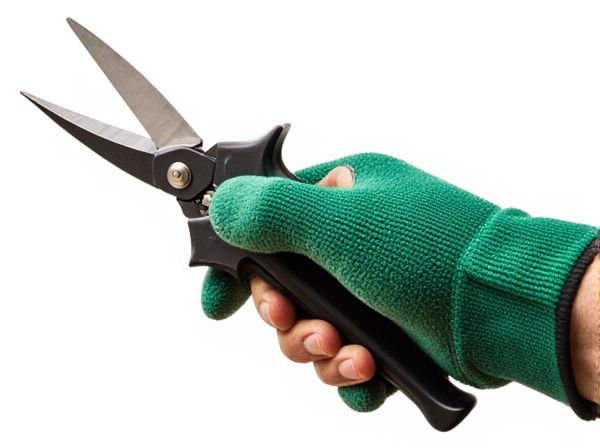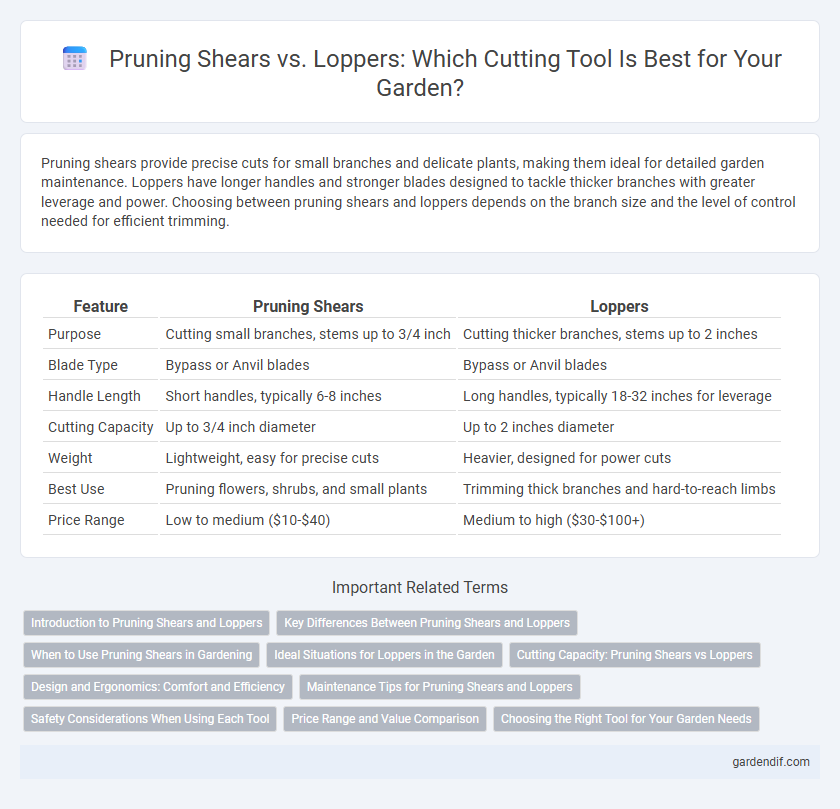
Pruning shears vs Loppers Illustration
Pruning shears provide precise cuts for small branches and delicate plants, making them ideal for detailed garden maintenance. Loppers have longer handles and stronger blades designed to tackle thicker branches with greater leverage and power. Choosing between pruning shears and loppers depends on the branch size and the level of control needed for efficient trimming.
Table of Comparison
| Feature | Pruning Shears | Loppers |
|---|---|---|
| Purpose | Cutting small branches, stems up to 3/4 inch | Cutting thicker branches, stems up to 2 inches |
| Blade Type | Bypass or Anvil blades | Bypass or Anvil blades |
| Handle Length | Short handles, typically 6-8 inches | Long handles, typically 18-32 inches for leverage |
| Cutting Capacity | Up to 3/4 inch diameter | Up to 2 inches diameter |
| Weight | Lightweight, easy for precise cuts | Heavier, designed for power cuts |
| Best Use | Pruning flowers, shrubs, and small plants | Trimming thick branches and hard-to-reach limbs |
| Price Range | Low to medium ($10-$40) | Medium to high ($30-$100+) |
Introduction to Pruning Shears and Loppers
Pruning shears, also known as hand pruners, are compact cutting tools designed for trimming small branches and stems up to 3/4 inch thick, providing precise cuts for detailed gardening tasks. Loppers feature longer handles, typically 18 to 30 inches, enabling greater leverage and reach to cut branches up to 2 inches in diameter efficiently. Both tools are essential in horticulture, with pruning shears suited for fine pruning and loppers ideal for thicker, hard-to-reach limbs.
Key Differences Between Pruning Shears and Loppers
Pruning shears, also known as hand pruners, are designed for cutting small branches and stems up to 3/4 inch in diameter, making them ideal for precise trimming and shaping of plants. Loppers feature long handles and can cut through thicker branches, typically up to 2 inches in diameter, offering greater leverage and reach for heavy-duty pruning tasks. The key differences lie in their size, cutting capacity, and intended use, with pruning shears suited for detailed garden maintenance and loppers optimized for larger branches and tougher cuts.
When to Use Pruning Shears in Gardening
Pruning shears are ideal for trimming small branches, typically up to 3/4 inch thick, and shaping delicate plants or flowers. They provide precision for detailed tasks like deadheading, thinning stems, and cutting herbs, ensuring clean cuts that promote healthy growth. For thicker, tougher branches, loppers are more suitable, but pruning shears excel in tasks requiring control and finesse.
Ideal Situations for Loppers in the Garden
Loppers excel in cutting thicker branches ranging from 1 to 2 inches in diameter, making them ideal for shaping trees and pruning larger shrubs. Their long handles provide significant leverage, allowing gardeners to reach higher or hard-to-access areas without the need for a ladder. Using loppers enhances precision and reduces strain compared to pruning shears when managing medium-sized woody plants.
Cutting Capacity: Pruning Shears vs Loppers
Pruning shears typically offer a cutting capacity of up to 3/4 inch in diameter, making them ideal for precise trimming of small branches and stems. Loppers provide a larger cutting capacity, often ranging from 1 to 2 inches, suited for thicker branches that are too large for pruning shears. Choosing between pruning shears and loppers depends on the size and thickness of the branches requiring clean cuts and efficient pruning.
Design and Ergonomics: Comfort and Efficiency
Pruning shears feature a compact, lightweight design ideal for precise cuts in tight spaces, with ergonomic handles that reduce hand fatigue during extended use. Loppers possess longer handles and a robust build, providing increased leverage and cutting power for thicker branches while often including cushioned grips to enhance comfort. Both tools prioritize efficiency, but pruning shears excel in dexterity, whereas loppers deliver superior reach and force for heavy-duty pruning.
Maintenance Tips for Pruning Shears and Loppers
Pruning shears require regular cleaning after each use to prevent sap buildup and rust, with blade sharpening recommended every few weeks to maintain cutting efficiency. Loppers benefit from occasional oiling of pivot points to ensure smooth operation and prevent joint wear, along with blade sharpening at least monthly depending on usage frequency. Proper storage in a dry environment and using a blade protector extend the lifespan of both pruning shears and loppers.
Safety Considerations When Using Each Tool
Pruning shears require careful hand positioning to avoid blade injuries and are best used with protective gloves to prevent cuts, while loppers demand attention to secure footing and controlled movements to manage their longer handles safely. Both tools should be inspected regularly for sharpness and stability to reduce the risk of accidents caused by slipping or tool malfunction. Proper storage and maintenance are essential to ensure user safety and prolong the lifespan of pruning shears and loppers.
Price Range and Value Comparison
Pruning shears typically range from $15 to $50, offering excellent value for light to medium garden tasks with their precision and ease of use. Loppers, priced between $30 and $100, provide greater leverage and cutting capacity for thicker branches, delivering optimal value for more demanding pruning needs. Choosing between pruning shears and loppers depends on balancing budget constraints with the required cutting power and durability for specific gardening projects.
Choosing the Right Tool for Your Garden Needs
Pruning shears are ideal for precise cuts on smaller branches up to 3/4 inch thick, offering excellent control for detailed garden work. Loppers provide greater leverage and reach, efficiently cutting branches up to 2 inches in diameter, making them suitable for larger shrubs and trees. Selecting the right tool depends on branch thickness and accessibility to ensure clean cuts that promote healthy plant growth.
Pruning shears vs Loppers Infographic

 gardendif.com
gardendif.com